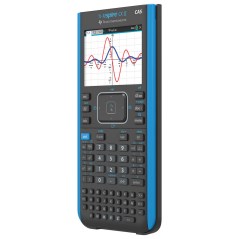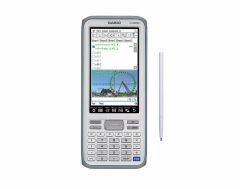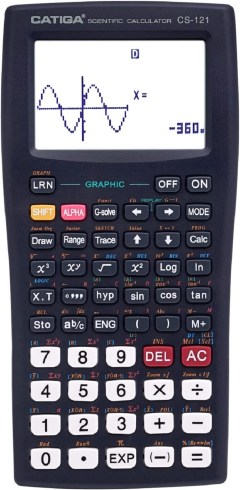BestReviews is reader-supported and may earn an affiliate commission. Details

With a vast array of graphing features and apps, this is a superb graphing calculator for college-level mathematics.
We can use the apps on this large, backlit, colorful calculator for geometry, statistics, programming and more. It's approved for the PSAT, SAT, AP and ACT. We appreciate the huge array of graphing features and options.
We would have found a USB-C or mini-USB port option useful.

This huge, innovatively designed graphing calculator is backlit with a full-color touch screen. We think it's a coursework necessity.
We feel comfortable with the PC-like interface and USB port, and we appreciate the apps for 3D graphing, geometry and chat. It comes with a stylus and is optimized for high-school math.
We find the viewing angles to be fairly narrow.

With its high-resolution display and compact design, the familiar TI-84 graphing calculator was greatly improved upon in this calculator.
This slim, lightweight calculator is easy for us to carry and navigate. It's approved for the PSAT, SAT and ACT. We like the crystal-clear, backlit color display and the wide range of color choices.
Some colors are more readily available than others.

We think this inexpensive Casio model is a worthy option. It provides basic yet reliable graphing functions for high-school mathematics.
We find this large, monochrome calculator to be affordable with an easy-to-use interface. We can get over 200 hours of battery life with it, and as a bonus, it comes with four AAA batteries. It's available in pink and blue.
Its secure clamshell packaging is a pain to open.

This inexpensive, feature-packed graphing calculator comes in handy for a variety of math courses.
With an array of graphing and scientific functions, we can use this calculator for geometry, algebra, statistics and probability. It's affordable with a large display and a protective cover. We like the multiple color choices.
The display is not backlit like some of the other calculators we've looked at.

We recommend these products based on an intensive research process that's designed to cut through the noise and find the top products in this space. Guided by experts, we spend hours looking into the factors that matter, to bring you these selections.

As a student advances through math classes in high school and college, the right calculator becomes an increasingly important tool to have at hand. Different calculators will give you different functionality, ultimately resulting in better success in class.
At some point, a math student will be required to know how to use a graphing calculator. This powerful handheld device can be expensive, but it can do things that lesser calculators cannot. If you or your child needs a graphing calculator for math class, you could be overwhelmed by all the choices.

If your only experience with a handheld calculator is solving simple addition and multiplication problems, you’re in for a shock. A graphing calculator can do all of those simple calculations, but that’s about where the resemblance ends.
A graphing calculator can solve simultaneous equations and plot the results on a graph that it displays on the screen. Dozens of buttons offer a multitude of functions, and you can run programs or apps that enable you to perform certain types of advanced calculations. It is basically a little computer that you can hold in the palm of your hand.
Ultimately, a graphing calculator helps students visualize mathematical concepts and better understand advanced concepts. And students can use this tool to check any work they’ve done by hand, ensuring accuracy.
When comparing graphing calculators, you’ll want to pay close attention to certain features and understand which ones are most important for the math classes you take.
A graphing calculator can run on alkaline or rechargeable batteries. Alkaline batteries can be more convenient, but if you use the calculator a lot, rechargeable batteries will save you money in the long run.
When picking out a graphing calculator, the display screen plays a big role in the usefulness of the unit. Some screens are larger than others, which could make a difference depending on how you’ll be using the device. Some screens are full color, while others are monochrome.
Pay attention to the screen resolution, too. A sharper screen more clearly shows the graphs and formulas, making them easier to read. Manufacturers measure resolution vertically and horizontally in pixels, such as 96 x 96 pixels.
You’ll want plenty of memory in a graphing calculator, especially if you will be performing highly advanced calculations.
The graphing calculator’s random-access memory (RAM) allows you to store functions and programs/apps. More memory makes it easier to store these items for the long term.
Graphing calculators also have read-only memory (ROM), but users can’t access it for storage. The manufacturer programs the ROM. When you see more ROM, it typically means the graphing calculator is more versatile.
Faster processors will enable you to work more quickly. Manufacturers measure speed in megahertz (MHz).

When comparing graphing calculators, you want to decide if you need one with a computer algebra system (CAS), which gives the calculator some additional features.
A CAS calculator performs much of the work automatically for the student. A teacher who wants to see a student’s work process won’t see it if the student is using a CAS graphing calculator.
The CAS graphing calculator can produce symbolic equations and symbolic results, simplifying equations and working with forms, rather than numbers. (This type of work generally isn’t required for students in the classroom, though. Instead, professionals or students in advanced college classes are likelier to need a CAS calculator.)
The CAS graphing calculator can expand and solve expressions, while returning all roots. It also can find the min, max, and zeroes for any function.
The non-CAS graphing calculator helps with calculations, but it forces the student to show his or her work.
The non-CAS graphing calculator creates fractional or decimal results by dealing with equations numerically only.
The non-CAS graphing calculator performs all of the calculations most students need for math classes. They’re most likely sufficient for any course other than advanced college courses for a mathematics major or graduate student.
If you’re used to spending $5 or $10 for a basic solar-powered calculator, you could experience some sticker shock when you shop for a graphing calculator, which can cost between $60 and $300. But remember that these devices are far more powerful than your basic calculator. The screens are more complex, the processors are faster, and the calculator contains more memory. For most classes that require a graphing calculator, the instructor should be able to recommend a price range for a calculator that fits the coursework.
And one other thing to remember about graphing calculators is that you can recoup some of the original cost by selling it later, as long as you care for it properly.
Inexpensive: You can expect to spend from $60 to $125 for a basic graphing calculator. A lot of units fit within this price range, and these calculators will do the job for most high school students. This price range also has popular brand names in it, so you won’t be limited to generic models. Most of these graphing calculators will not have high-end display screens, but the screens are more than adequate for basic work.
Mid-Range: You will find a large variety of graphing calculators that cost $125 to $150. For high school students taking advanced classes or first-year college students, a graphing calculator in this price range will have the features they need.

Q. Will a graphing calculator help me get better grades in math class?
A. Certainly, a graphing calculator can help students have more success with graphing functions. This should help them finish homework and tests more quickly and with more correct answers. However, in order to be able to use a graphing calculator successfully, students still need to understand algebra. Most students do better with graphing calculators once they’ve gained an understanding of the concepts the old-fashioned way – with pencil and paper.
Q. What’s the best graphing calculator for a high school student?
A. For those just starting to use graphing calculators, an inexpensive basic model should provide the level of performance they need. Look for a calculator that has large, clearly marked buttons. This helps students just starting to learn these functions to select the right function every time.
Q. How do I know if I’m purchasing a powerful graphing calculator?
A. Much like a computer or smartphone, a more powerful graphing calculator has a more powerful processor. A graphing calculator’s processor is much smaller than the one found in a smartphone or computer, certainly, but different graphing calculator processors run at different speeds, measured in MHz. Faster graphing calculators can perform calculations more quickly, saving you serious time when you’re performing dozens of calculations.
Q. Do I really have to spend the extra money for a graphing calculator when I already have a scientific calculator?
A. A scientific calculator performs a lot of advanced mathematical calculations. However, for certain types of math that require graphing, the scientific calculator can’t perform the necessary calculations. Only the graphing calculator has the ability to provide more visual answers. Additionally, the graphing calculator can typically match all of the functions of a scientific calculator.
Get emails you’ll love.
Learn about the products you’re wondering if you should buy and get advice on using your latest purchases.
